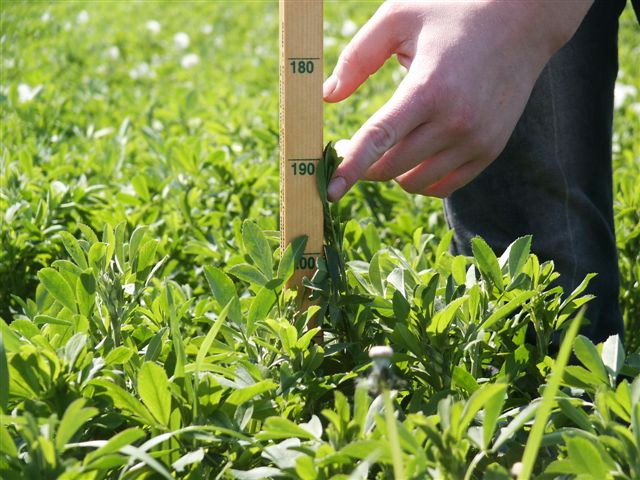Local dairy farmers want high quality alfalfa haylage for their cows, especially the first cutting of this 4-cut crop since it provides over half of the total haylage harvest for the year. Farmers wait 28-30 days between cuttings to harvest the optimal quality in haylage, but how do we determine when to cut the first crop?
The first harvest of alfalfa is typically the highest yielding yet the most difficult crop to put up in a timely manner. First cutting alfalfa harvest is based on quality and not a set date. To remove the guesswork and help farmers determine when the optimal time to harvest first crop alfalfa, they can conduct a PEAQ (Predictive Equations for Alfalfa Quality) estimate in the field, by measuring the longest stem and the most mature step in an area to estimate the Relative Feed Value (RFV) of the alfalfa. Comparing the height of the plant and the maturity of the feedstuff, farmers can determine the quality of the forage by using the chart at https://manitowoc.extension.wisc.edu/files/2022/05/PEAQTable.pdf. The goal of the farmer is to harvest the alfalfa to have a 180 RFV or greater at time of feeding it to the dairy cows; therefore farmers plan to harvest the alfalfa 10 to 25 points higher to account for changes due to drying and ensiling.
Fond du Lac County Forage Council and the Fond du Lac County Forage Council will once again provide the Alfalfa Quality Watch Project to assist local farmers in determining when the optimal time to harvest alfalfa. Standing alfalfa samples will be collected and submitted for laboratory analysis every Monday beginning May 22, 2023 until alfalfa has been harvested, with results available on Tuesday at https://fyi.extension.wisc.edu/fdlag/alfalfa/. Along with the laboratory results, a PEAQ estimate will be shared for farmers to compare their own height of the plant to the actual laboratory results from 3 representative fields across the county to assist them in deciding when to harvest based on quality.





